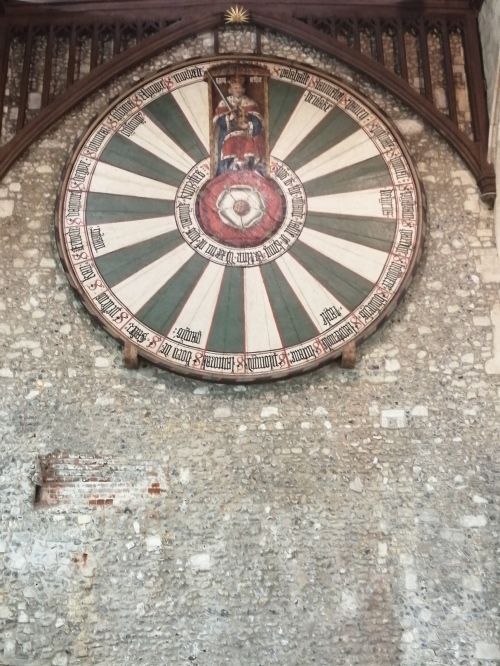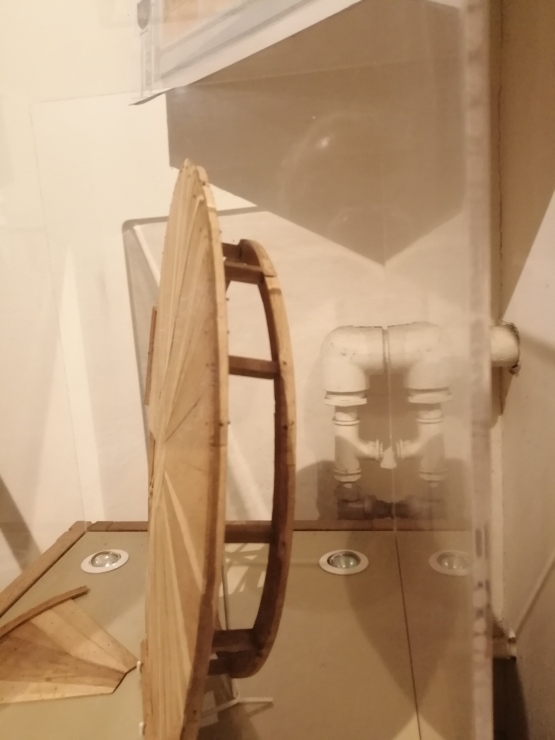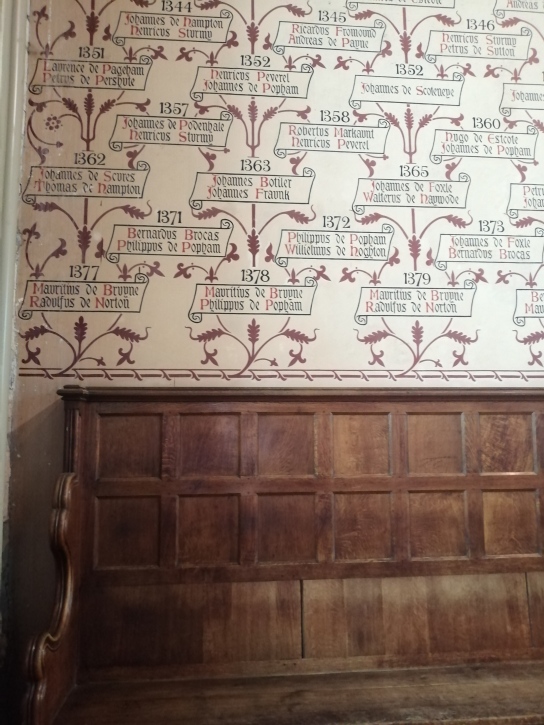
The Round Table, Great Hall, Winchester
During a recent trip to Winchester I visited what remains of its medieval castle. The castle was built at the highest point of the town, which was also the furthest point from the river. The only remnants of the castle these days are some stumps of walls, some vaults which are closed to the public, and the Great Hall.
You’ve probably come across the Great Hall in photographs, even if you didn’t know what it was. It’s best-known today for housing the Round Table and that’s what tourists pay to see. There’s a bit more to the Great Hall than that, but it’s what we’ll start with.
Edward I had the Round Table built, probably around 1290 for a banquet. He didn’t have it painted with the portrait of King Arthur and the names of the knights, though. The Tudor Rose in the middle of the table is a clue to the identity of the king who did have it painted: Henry VIII. King Arthur’s face was originally that of the young Henry, which must have been a bit confusing for him, since his older brother, who would have been king had he lived, was called Arthur. Over the years, various renovations have changed the features of King Arthur into those of an old man. It was only because X-rays were used during one of the more recent renovations that we have any idea of what King Arthur originally looked like. The Victorians, as is usually the case, were probably the guilty parties here.
The table is massive. It’s 18 feet in diameter and weighs 1 ton 4cwt. It was made of 121 separate pieces of oak and had 12 legs. When it was renovated in the 1970s, the wood was dated by means of dendrochronology and the youngest tree-ring they found was dated to 1219, suggesting that the trees used were felled no later than the second decade of the fourteenth century.
There’s a model of its original construction on display just outside the hall.

Model of the Round Table, Great Hall, Winchester

Model of the Round Table, Great Hall, Winchester
The castle itself was originally built by William the Conqueror at the end of the eleventh century. Henry III was born there in 1207 and it was he who had the Great Hall built. A fire during the reign of his son, Edward I damaged the royal apartments so badly that they were never repaired and the royal family thereafter stayed in the palace of the Bishop of Winchester whenever they visited.
The Great Hall was used as a courtroom from the reign of Henry III off and on until 1973. Famous trials that took place there included those of the Earl of Kent (a son of Edward I) in 1330 and Sir Walter Raleigh in 1603.
The Great Hall has other delights, not least a herber garden set out in a style that would have been familiar to Edward I’s queen, Eleanor, who brought a number of plants to England from her native Castile.

Queen Eleanor’s Garden, Great Hall, Winchester
The Victorians tried hard with their renovation. This wall, where the Round Table was hung after it was no longer needed for its original purpose, is covered with the names of the parliamentary representatives for Hampshire from 1283 to 1868. For many years, possibly centuries, there was a medieval mappa mundi on this wall.

Great Hall, Winchester
They also made an effort with the windows. Apparently the long walls of the hall were originally painted with heraldic devices. The Victorians put devices of kings, queens, bishops and others important to the history of Hampshire in the windows. Here’s the window with the devices of Edward III, his son Edward of Woodstock, and his great friend William Montacute.

Great Hall, Wincester
The Great Hall is well worth a visit if you’re ever in Winchester.
April Munday is the author of the Soldiers of Fortune and Regency Spies series of novels, as well as standalone novels set in the fourteenth century.
Available now:




The current Winchester Cathedral is one of my favourite places. I especially like visiting the underground croft and the statue of a man which is usually knee deep in water most of the time. This is due to several rivers converging under the Cathedral.
LikeLiked by 1 person
I shall be going to the cathedral once the school holidays are over. I don’t think I’ve been in the undercroft. If I have, it was 50 years ago. The museum between the cathedral and the High Street has been recommended to me, so I might visit that later this month.
LikeLiked by 1 person
There is something very profound about that statue…
LikeLiked by 1 person
A fascinating article. Another place to visit on my UK list. I am never going to go on holiday anywhere else in the world at this rate. To many interesting things to see in England, Scotland and Wales.
LikeLiked by 2 people
Thank you. There are indeed loads of interesting places. I’ve just come back from a couple of days in Bath, where there are many things to see. I drove back via Salisbury, which is also worth a visit of at least a couple of days. I passed Stonehenge on my way to Bath, but it’s incredibly busy at this time of year.
LikeLike
A place I’d like to visit! Fab post April.
LikeLiked by 2 people
Thank you, Fraggle. It’s definitely worth a look if you’re ever in Winchester.
LikeLiked by 1 person
I did know a little about the Great Hall but this was so interesting and informative as always with your posts.
LikeLiked by 1 person
Thank you, Rachael. I knew it would be impressive, because I’ve seen the outside a few times on my way to the station. It’s changed quite a bit over the centuries; the Victorians weren’t the only ones who liked to remodel and redecorate.
LikeLiked by 1 person
Great post, I love the Great Hall and haven’t visited it in years. I will add it to my list of ‘April inspired’ places to visit. X
LikeLiked by 2 people
I’m glad you’ve got a list :-). You could also have a look at Westgate, which is just by the Great Hall. There’s a museum in it. It’s mostly about the Tudors and Stuarts, but there’s also something about the Civil War. You can also go onto the roof. It’s not very high, but it’s quite fun.
LikeLike
I visited this place a few years ago and loved it. The herb garden is very lovely. Some great pictures!
LikeLiked by 1 person
Thank you. The herber was past it’s best when I went. Although June was very wet, July was very dry, so some of the flowers were less than happy. I think it probably looks its best in June.
LikeLiked by 1 person
I’ve only been in Winchester briefly. We were Jane Austening that day, and on our way to the J. A. house/museum, where we spent a fair amount of time. Thence to Chawton House, which we hadn’t previously known about. That pretty much took up our day, so Winchester itself is on our let’s-go-back-and-have-a-better-look list.
As for the Victorians: oh dear. There were indefatigable researchers, writers, and editors among them whose generally reliable works are now available on line, but the alternative history of romantic restorations and myth-makings is a bit much.
LikeLiked by 1 person
I’ve been to Chawton Cottage, but never to the big house. Sadly, the house Jane Austen lived in in Southampton has long since gone. It annoys me slightly that Bath, which she hated, and Winchester, where she only lived a few weeks and died , get all the attention. She was happy, if busy, for three years in Southampton.
I’m afraid that I now refer to Victorians as vandals. I know nothing stays the same and buildings are changed over time for different uses and fashions, but the Victorians simply recreated a romanticised medieval past that never existed. They enjoyed ‘improving’ things.
LikeLiked by 1 person
We were fascinated by Chawton House, and speculated darkly about how it might have felt to be the poor relatives in the cottage down the road.
LikeLiked by 1 person
I think it probably felt very good to be the poor relatives down the road. They finally had a home that was theirs. They weren’t living in the home of any of the Austen men, but they visited them frequently. They had a measure of independence, which must have been very welcome. They knew that there was enough money to allow them to live well for the rest of their days.
LikeLiked by 1 person
Independence and security were certainly theirs. My friend and I are a couple of old cynics. As we prowled around the cottage it struck us that Jane wouldn’t have had much trouble in securing a “room of one’s own” if she’d really wanted one.
LikeLiked by 1 person
Indeed
LikeLiked by 1 person
It’s a shame about the Victorians, but—echoing everyone else—this does sound like a lovely place to visit!
LikeLiked by 1 person
It is worth a look.
LikeLiked by 1 person